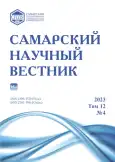Natural forming of vegetation cover on black coal mining dumps in the environs of Kopeysk (Chelyabinsk Oblast)
- Authors: Nazarenko N.N.1,2, Dolgonos X.A.1
-
Affiliations:
- South Ural State Humanitarian Pedagogical University
- South Ural State Medical University
- Issue: Vol 12, No 4 (2023)
- Pages: 71-77
- Section: Biological Sciences
- URL: https://journals.rcsi.science/2309-4370/article/view/260637
- DOI: https://doi.org/10.55355/snv2023124110
- ID: 260637
Cite item
Full Text
Abstract
The article considers the current forming of vegetation and biotopes as a result of natural overgrowth of territories disturbed during black coal mining in the environs of Kopeysk town (Chelyabinsk Oblast). The 88 species of vascular plants were detected on the waste banks and spaces between them, the 7 species of vascular plants are woody species. It has been established that in the process of natural overgrowth of dumps, forest and meadow plant communities are actively formed from pioneer ruderal and halophytic communities. By methods of multidimensional statistics, 15 phytocoenochores have been determined and the discriminate of which is d identified by the tree species, which are forming the forest canopy. The identified plant communities are characterized by specific regimes of the fundamental abiotic factors of biotopes and make up a series of biotopic and coenotic substitution, forming a sylvant (forest) and pratant (meadow) successional series. It has been shown that in the process of natural overgrowth, the formation of forest (primarily birch) and meadow coenoses proceeds in parallel, and the invasive species Acer negundo L. plays an active role in sylvatization. It has been established that the leading hand in the formation of the coenotic structure of communities belongs to soil mineralization, acidity, aeration and variability of soil moisture. The obtained data on biotopes and successional series can be used in the development of the biological stage of landfill revegetation after coal mining impacts with the formation of woody or grass plant communities.
Full Text
##article.viewOnOriginalSite##About the authors
Nazar N. Nazarenko
South Ural State Humanitarian Pedagogical University; South Ural State Medical University
Author for correspondence.
Email: 1000nnn@rambler.ru
doctor of biological sciences, professor of Chemistry, Ecology and Chemistry Methodology Department, professor of Biochemistry Department named after R.I. Lifshits
Russian Federation, Chelyabinsk; ChelyabinskXenia A. Dolgonos
South Ural State Humanitarian Pedagogical University
Email: dornerksen02@gmail.com
student of Natural Sciences and Technologies Faculty
Russian Federation, ChelyabinskReferences
- Колмогоров В.В. С чего начиналась угольная история Копейска // Гороховские чтения: мат-лы седьмой региональной музейной конференции / под науч. ред. Н.А. Антипина. Челябинск: ОГБУК Государственный исторический музей Южного Урала, 2016. С. 376–378.
- Осипчук А.И., Тюнин А.И. Геоэкологические последствия, связанные с добычей угля в Челябинской области // Педагогическая и гуманитарная сферы: история и современность: мат-лы III всерос. науч.-практ. конф. Шадринск: Шадринский государственный педагогический университет, 2021. С. 67–75.
- Колесников Б.П., Махонина Г.И., Чибрик Т.С. Естественное формирование почвенного и растительного покровов на отвалах Челябинского буроугольного бассейна // Растения и промышленная среда. Вып. 4. Свердловск: Свердловский ГУ, 1976. С. 70–122.
- Глазырина М.А. Особенности формирования флоры и растительности в условиях отвалов и карьеров открытых угольных разработок (на примере Челябинского буроугольного бассейна): автореф. дис. … канд. биол. наук: 03.00.16, 03.00.05. Екатеринбург, 2002. 17 с.
- Глазырина М.А., Чибрик Т.С., Филимонова Е.И., Лукина Н.В. Восстановление растительности на террикониках Челябинского буроугольного бассейна // Проблемы экологии Южного Урала: сб. мат-лов IX всерос. науч.-практ. конф. с междунар. уч. М.: Дом педагогики, 2019. С. 76–80.
- Чернышева С.В., Сокол Э.В., Максимова Н.В. Копейский угольный район: реконструкция источников техногенного запыления // Минералогия техногенеза. 2005. Т. 6. С. 214–228.
- Зенкина А.А. Воздействие угольных терриконов г. Копейска на почву и воды прилегающих территорий // Научные исследования молодых ученых: сб. ст. V междунар. науч.-практ. конф., 27 июля 2020 г. Пенза: Наука и просвещение, 2020. С. 21–25.
- Куликов П.В. Конспект флоры Челябинской области (сосудистые растения). Екатеринбург–Миасс: Геотур, 2005. 537 с.
- Ханина Л.Г., Смирнов В.Э., Бобровский М.В. Новый метод анализа лесной растительности с использованием многомерной статистики (на примере заповедника «Калужские засеки») // Бюллетень Московского общества испытателей природы. Отдел биологический. 2002. Т. 107, вып. 1. С. 40–48.
- McCune B., Grace J.B. Analysis of ecological communities. MjM SoftWare Design, 2002. 300 p.
- Legendre L., Legendre P. Numerical ecology. Amsterdam: Elsevier Science B.V., 1998. 853 p.
- Заугольнова Л.Б. Иерархический подход к анализу лесной растительности малого речного бассейна (на примере Приокско-террасного заповедника) // Ботанический журнал. 1999. Т. 84, № 8. С. 42–56.
- Didukh Ya.P. The ecological scales for the species of Ukrainian flora and their use in synphytoindication. Kiev: Phytosociocentre, 2011. 176 p.
- Persson S. Ecological indicator values as an aid in the interpretation of ordination diagrams // Journal of Ecology. 1981. Vol. 69, № 1. P. 71–84.
- Терентьев П.В. Метод корреляционных плеяд // Вестник Ленинградского государственного университета. 1959. № 9. С. 137–141.
Supplementary files







